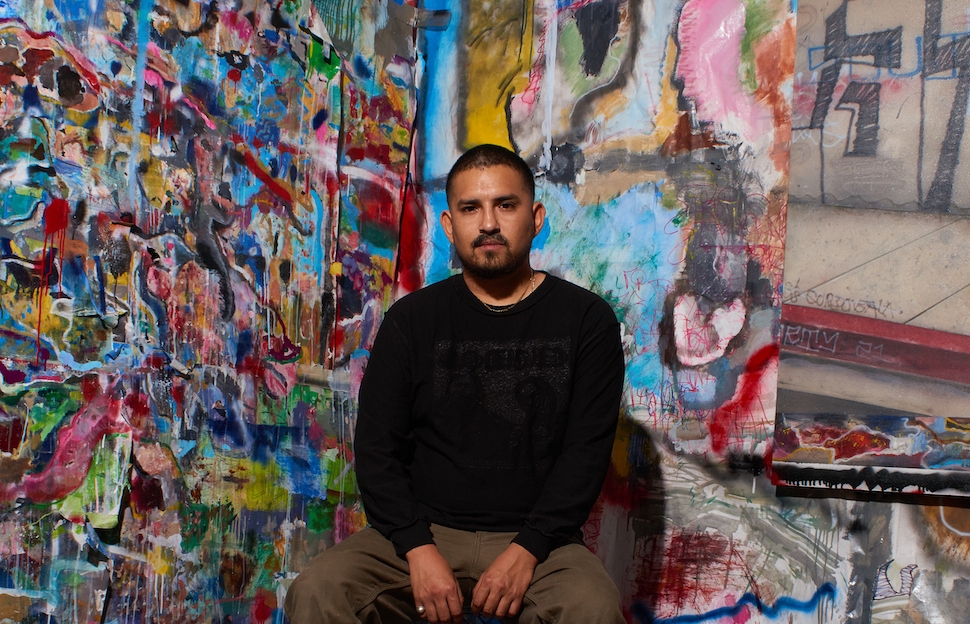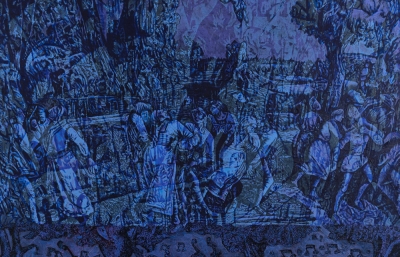Alfonso Gonzalez Jr
The Power of Observation
Interview by Kristin Farr // Portrait by Eduardo Medrano Jr
Look at your environment from a perspective like the one held by breakthrough observationalist Alfonso Gonzalez Jr. and you see that art is everywhere. The artist views land and cityscapes through an archeological lens, studying the evolution of visual communication, early on through a camera, and now with paint. His work is a record of time, fragmented moments that will look different by tomorrow—an ever-changing LA street patina captured by his perceptive eye that fathoms the layers of time, excavating the heart from the fades and ephemerality of existence. Alfonso’s inspired realities shape and push forward the rightful narratives of our time.
Kristin Farr: What attracts you to weathered surfaces?
Alfonso Gonzalez Jr: When I see a weathered surface in LA, I think about the people and community. It’s people who influence and change a surface. I’m constantly amazed by people's aesthetic decisions, and a community's relationship to public space—like why someone chose to name a business a certain name, or paint a building a certain color, why the truck driver chose to paint a Looney Tunes character, and the teenager decided to draw a penis on the face of a real estate agent on the bus bench, the rivalries between LA hoods, the sloppy erasure of unwanted graffiti. These are all stories and decisions of how a city comes to look the way it does.

Is your work a method of preserving time?
I see my work as documentation, like archiving and archaeology. With the world changing at such a rapid rate, this is the last time our cities are going to look the way they do. I want to preserve and convey to people that our communities are beautiful. And I want to compel people to look for what the communities before them left behind—the traces, imperfections, culture.
How else does contemporary life influence your practice?
Since I grew up looking at screens, it impacts the way I approach a new work. I found that, when making compositions, my mind sometimes thinks about viewing them on a screen and cropping the image with the zoom option. My recent work focuses on landscapes. I find a cohesive parallel with the work by imagining the environment on Google Maps. Zooming in and out, walking around the corner down the street, in and out of a building, looking up, down and around. The irony is that I’m terrible with computers and tech. I still approach the production of my work the old school way, the way I learned through sign painting.
Tell me about your Dad, the sign painter.
My dad Alfonso Gonzalez Sr., a.k.a. AL SIGNS, has been painting signs for over 40 years. He’s originally from Tijuana and moved to City Terrace, Los Angeles, in the early 1970s. He’s always had an art practice and began painting commercially as a career. Because of him, I grew up around books and magazines about Mexican muralism, airbrush painting, lowrider and car culture. The first book I remember looking at was on David Alfaro Siqueros. My father continues to paint signs and make art. I see truck lettering he’s done everytime I drive on a Southern California highway.

Since you reference it as inspiration, talk about your neighborhood.
I currently live and work in East Los Angeles. My parents’ folks both came to East LA when they immigrated to the U.S, so I have fond memories of family here. It’s 96% Latino—the highest percentage of any neighborhood in Los Angeles County. The area is rich with history and culture. Some of the movements I found the most inspiring flourished in East LA, collectives like Asco, Los Four and the East Los Streetscapers.
When I was a kid, I lived in Avocado Heights, an equestrian area in unincorporated LA. Avocado Heights is still equestrian and semi-rural. It feels like a ranch in Mexico. The juxtaposition of rural ranch and industrial warehouses in California gave me a unique perspective and was a reminder that the identity of the city stretches beyond the Hollywood experience.
What’s an example of reference to yourself or someone you know in one of your paintings?
In Avocado Heights from 2019, I painted the house I grew up in. The painting referenced a current version of my old house. Although the home looks different now, I remembered exactly how it used to look and feel when I was younger. This was the first time the cholo on the horse appeared. Years later, I focused on the cholo again in Sueños (2021). Sueños embodies the memories, dreams, and daily life I experienced growing up in the equestrian and semi-rural barrio of Avocado Heights. Throughout my formative years, I looked up to the local youth within this community that rode horses in their ’90s-style clothing. This style of dressing was criminalized and led to racial profiling. Sueños is an exploration and a homage to the distinctive lifestyle born from the convergence of Mexican paisa culture and LA gang culture. Set amongst the mountainous and semi-industrial landscape of my youth, this work not only commemorates my hometown, but also challenges historic representations of power. Colonizers have often been portrayed as valiant white men on horseback in oil paintings throughout history. I subvert this cliched image of strength and masculinity by substituting the “heroic” white male with the cholos who roamed my childhood community on horseback.

Who do you prioritize as the audience for your artwork?
I don’t prioritize an audience for my work. I would like to think almost everyone can see my work and come up with an idea about it. One of the greatest things about being an artist is the wide range of people I come into contact with. The conversations I have directly inform ideas and subjects in my work. The perspective of a street vendor or a professor are equally as valuable to me. Some people are drawn to the materials and process, others are more interested in the idea behind it.
What are some ways you’ve noticed LA change over time that come up in your work?
Los Angeles changing over time has been a big drive in the work I make. Years before I started making paintings, I was obsessively documenting Southern California with a deep focus on LA. I began traveling in my late teens and early twenties, and every time I’d come back home, I'd see the erasure of culture in torn down buildings with new stale developments, and the erasure of murals became the norm. The Covid-19 pandemic accelerated this process of family owned businesses being forced to close and everything else that comes with gentrification. Some of the subjects I allude to in my work are directly referenced from that reality. I make a lot of work of imagined compositions that don't exist, but that I feel would exist in real life.
Any memorable stories from your recent travels in Europe and elsewhere?
The last time I was in Europe was in March 2020 for a group show in Berlin. It was around the time when Covid rates started rising. I was there for a week, and I saw how people’s mannerisms changed at the airport. When I first was at the airport, some people wore masks, and then when I was coming back, people were in hazmat suits - all in a week’s time. I flew back two days before the borders shut.
What were some of the paintings you made that documented these times we’re living in?
It was fascinating to see completely empty freeways during the beginning of the pandemic. Los Angeles is known for heavy traffic, but it was a post-apocalyptic LA. I never thought I'd see something like that in my lifetime. I made a work focusing on the empty highways. Another work I made during that time was an advertisement for Fabuloso, a common household cleaning product. During Covid, I started noticing ads in my neighborhood for cleaning products more than ever. A sign of the times.

Any other unintentional art or street scene in the current landscape that recently caught your eye?
I've been watching the construction of the 6th Street bridge over the Los Angeles River and 101 freeway. I see it every day on the way to the studio, and it's been fascinating to see the evolution of the construction. I’m drawn to the exposed wood and steel that will eventually be covered by concrete. I find the stage before the concrete to be the most visually appealing. Once it’s complete, it’s easy to forget about the labor and materials that went into it.
How did you develop such perfect painting skills?
Thank you for thinking that, but I don’t paint perfectly, and I’m fine with that. I love brush strokes and subtle imperfections. I do have an admiration for the people who take the time to develop craft and skill. I also love people who don’t care or focus on perfection. I think what makes any work good is if it's genuine.
I didn’t go to art school; instead I attended Doc Guthrie’s Sign Graphics course at LA Trade Tech Community College. The first jobs I had after high school were as a freelance sign painter and working for different sign shops. I eventually started working as a low-level apprentice with a company that paints large outdoor advertisements on the sides of big buildings. My only experience then was lettering and a basic understanding of oil and enamel paint. The people I worked with had a vast experience reproducing any image and advertisement. Before digital printing, everything was painted. I had the opportunity to work with old billboard painters who started before computer printers took over. After years of watching, painting backgrounds and simple areas, I began to understand the process. I saw the process of producing these large-scale murals like painting using a microscope. It allowed me to see things that would have been invisible or subtle on a smaller scale. It made m

What are you working on now?
I’m doing my first solo show at Matthew Brown Gallery LA in early 2022. I’m excited to show work in other countries and expand my practice, and I’m grateful to keep doing the work.
Your reference to the line-up of shoplifter photos behind the counter at corner stores as photo installations really stuck with me.
I see so many fascinating and thought-provoking things, like coin machine rides, bounce houses and lunch truck murals, and I connect them in my work. It makes me wonder how many more artists the world would have if people had the opportunity. It's intriguing to see the space and context of objects being displayed, and how that influences their perception and value. I also don’t believe all stunning work needs to be shown in galleries and institutional spaces to make it engaging. There’s something pure about creating for the sake of creating. So many people who have an appreciation of art are afraid to attempt making something because of insecurities of it being bad. There is an unrestrained freedom about work that is in public spaces. When the pressure is off is when the authentic expression comes out.
*






